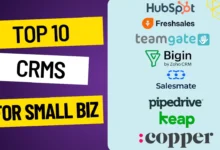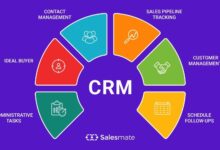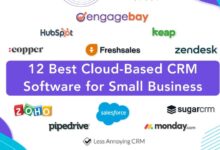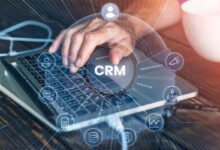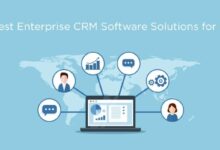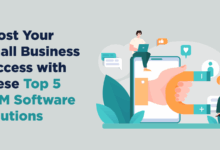Best Enterprise CRM Software: A Comprehensive Guide
Best enterprise CRM software is crucial for businesses aiming to streamline operations and enhance customer relationships. This guide delves into the key features, leading vendors, implementation strategies, and future trends shaping the enterprise CRM landscape. We’ll explore how to choose the optimal system based on your specific needs and budget, ensuring a successful integration that drives growth and improves customer satisfaction.
From defining the criteria for selecting the “best” software to examining critical features like contact management, sales automation, and marketing automation, we provide a detailed analysis of the market. We’ll also discuss the importance of data security and compliance, covering essential regulations and best practices to protect sensitive information. The guide concludes by looking ahead at emerging trends like AI-powered features and predictive analytics, highlighting how these advancements will continue to revolutionize customer relationship management.
Defining “Best” Enterprise CRM Software
Selecting the “best” enterprise CRM software is not a simple task; it necessitates a nuanced understanding of your organization’s unique needs and a thorough evaluation of various software options. The ideal CRM seamlessly integrates with existing systems, enhances productivity, and delivers a substantial return on investment. This requires careful consideration of several key factors.
Defining “best” involves a multi-faceted approach, prioritizing criteria that directly impact operational efficiency, data security, and overall business growth. These criteria are not equally weighted; the relative importance of each will vary depending on the specific enterprise and its priorities. For instance, a rapidly scaling startup might prioritize scalability and ease of use above advanced analytics features, while a large multinational corporation might prioritize robust security and compliance features above all else.
Criteria for Evaluating Enterprise CRM Software
The selection of the best enterprise CRM software hinges on several crucial factors. A robust evaluation process should consider scalability, security, integration capabilities, user experience, reporting and analytics, customization options, and overall cost. A weighted rubric can help objectively compare different systems.
Enterprise CRM Software Evaluation Rubric
The following rubric provides a framework for evaluating enterprise CRM software. The weighting assigned to each criterion reflects its general importance, but these weights should be adjusted based on the specific needs and priorities of the organization.
| Criterion | Weighting | Scoring (1-5, 5 being highest) | Comments |
|---|---|---|---|
| Scalability | 25% | Can the system handle increasing data volumes and user numbers? | |
| Security | 20% | Data encryption, access controls, compliance certifications (e.g., ISO 27001, SOC 2). | |
| Integration Capabilities | 15% | Seamless integration with existing ERP, marketing automation, and other business systems. | |
| User Experience | 15% | Intuitive interface, ease of navigation, and user-friendliness. | |
| Reporting & Analytics | 10% | Comprehensive reporting capabilities, customizable dashboards, and advanced analytics features. | |
| Customization Options | 10% | Ability to tailor the system to meet specific business needs and workflows. | |
| Cost | 5% | Total cost of ownership, including licensing fees, implementation costs, and ongoing maintenance. |
Enterprise CRM Software Pricing Models
Understanding the various pricing models is essential for budgeting and cost management. Different vendors offer different approaches, each with its own advantages and disadvantages.
| Pricing Model | Description | Advantages | Disadvantages |
|---|---|---|---|
| Subscription (SaaS) | Recurring monthly or annual fees based on the number of users or features. | Predictable costs, automatic updates, scalability. | Ongoing expenses, potential vendor lock-in. |
| Perpetual License | One-time purchase of the software license. | Lower upfront costs (potentially), ownership of the software. | Higher initial investment, additional costs for updates and maintenance. |
| Usage-Based | Fees based on actual usage of the software, such as the number of transactions or data stored. | Pay only for what you use, potentially lower costs for low usage. | Unpredictable costs, potential for unexpected expenses. |
| Hybrid Models | Combination of subscription and perpetual license or usage-based models. | Flexibility to tailor pricing to specific needs. | Increased complexity in cost management. |
Key Features of Top Enterprise CRM Systems
Enterprise CRM systems are the backbone of modern business operations, providing a centralized platform to manage customer interactions and streamline various business processes. Their effectiveness hinges on a robust set of features designed to enhance efficiency, improve customer relationships, and drive revenue growth. Understanding these key features is crucial for businesses looking to leverage the full potential of a CRM system.
Choosing the right enterprise CRM requires careful consideration of its core functionalities. Leading systems offer a comprehensive suite of tools designed to manage the entire customer lifecycle, from initial contact to post-sales support. The integration of these features ensures a seamless flow of information across departments, leading to improved collaboration and a unified customer view.
Core Functionalities of Leading Enterprise CRM Systems
Top-tier enterprise CRM systems offer a range of core functionalities designed to manage various aspects of customer interactions and business operations. These functionalities are often modular and customizable to fit specific business needs. Effective implementation relies on a clear understanding of how these modules work together to achieve a unified customer view and streamline processes.
- Contact Management: This centralizes all customer data—contact details, communication history, purchase history, and interactions across various channels—providing a 360-degree view of each customer. This allows for personalized interactions and targeted marketing campaigns.
- Sales Force Automation (SFA): SFA tools automate sales processes, from lead generation and qualification to opportunity management and forecasting. Features like lead scoring, pipeline management, and sales activity tracking provide valuable insights into sales performance and identify areas for improvement. For example, a sales team can track the progress of deals through different stages, enabling better resource allocation and more accurate sales forecasting.
- Marketing Automation: This functionality automates marketing tasks such as email marketing, social media campaigns, and content distribution. Features like lead nurturing workflows, campaign tracking, and A/B testing help optimize marketing efforts and improve conversion rates. Imagine automatically sending personalized email sequences to leads based on their engagement level, ensuring consistent communication and increasing the likelihood of conversion.
- Customer Service Support: This module streamlines customer support processes, providing tools for managing customer inquiries, resolving issues, and tracking customer satisfaction. Features like ticketing systems, knowledge bases, and self-service portals enhance customer experience and reduce response times. A company might use a CRM’s helpdesk functionality to route customer inquiries to the appropriate agents based on skillset and availability, leading to quicker resolution times.
Customization and Integration Capabilities
The ability to customize and integrate a CRM system is crucial for aligning it with a company’s unique business processes and existing technology infrastructure. Customization allows businesses to tailor the system to their specific needs, while integration ensures seamless data flow between the CRM and other critical systems. This avoids data silos and provides a holistic view of customer interactions.
Customization options might include configuring workflows, adding custom fields, and creating reports tailored to specific business metrics. Integration capabilities allow for seamless data exchange with systems such as ERP, marketing automation platforms, and e-commerce solutions. For instance, a company could integrate its CRM with its e-commerce platform to automatically update customer purchase history within the CRM system, enabling personalized recommendations and targeted marketing efforts.
Essential Features by Industry Vertical
The specific features needed in an enterprise CRM system vary significantly depending on the industry. Understanding these industry-specific requirements is crucial for selecting the right solution.
- Healthcare: Patient relationship management (PRM), HIPAA compliance, appointment scheduling, electronic health records (EHR) integration, and patient portal integration.
- Finance: Regulatory compliance (e.g., KYC/AML), financial transaction tracking, risk management tools, client portfolio management, and wealth management features.
- Manufacturing: Inventory management, supply chain integration, production scheduling, customer order tracking, and field service management.
Comparing Leading Enterprise CRM Vendors
Choosing the right enterprise CRM system is a critical decision, impacting sales, marketing, and customer service efficiency. This section compares three leading vendors—Salesforce, Microsoft Dynamics 365, and SAP Customer Experience—to help you navigate the selection process. We’ll analyze their strengths and weaknesses across functionality, pricing, support, target markets, and integration capabilities.
Leading Enterprise CRM Vendor Comparison
The following table provides a comparative analysis of Salesforce, Microsoft Dynamics 365, and SAP Customer Experience. Note that pricing is highly variable and depends on specific modules, users, and customization needs.
| Feature | Salesforce | Microsoft Dynamics 365 | SAP Customer Experience |
|---|---|---|---|
| Functionality | Comprehensive suite covering Sales Cloud, Service Cloud, Marketing Cloud, Commerce Cloud, and more. Highly customizable and scalable. | Robust platform integrating sales, service, marketing, and operations. Strong integration with other Microsoft products. | Extensive functionality encompassing sales, service, marketing, and commerce, deeply integrated with other SAP enterprise solutions. |
| Pricing | Subscription-based, with various pricing tiers and add-ons. Can be expensive for large deployments. | Subscription-based, offering various plans and licensing options. Generally considered more competitively priced than Salesforce. | Subscription-based, often requiring significant upfront investment and ongoing maintenance costs. Pricing varies greatly depending on modules and customization. |
| Support | Extensive documentation, online support communities, and dedicated support teams. However, support costs can be substantial. | Strong support network including online resources, community forums, and dedicated support staff. Integration with Microsoft’s broader support ecosystem is a plus. | Comprehensive support resources, but may require specialized expertise due to the complexity of the platform. Support costs can be significant. |
| Target Market | Broad range of businesses, from small to large enterprises, across various industries. Particularly strong in sales-driven organizations. | Appeals to businesses seeking seamless integration with their existing Microsoft ecosystem. Strong in mid-market and enterprise segments. | Primarily targets large enterprises with complex business processes and existing SAP investments. Best suited for companies requiring deep integration across various business functions. |
Integration Options
Each vendor offers various integration options to connect with other business systems.
Salesforce provides extensive integration capabilities through its AppExchange marketplace, offering pre-built connectors and APIs. It supports a wide range of technologies and protocols, allowing seamless integration with various third-party applications and custom-built solutions. Examples include integrations with marketing automation platforms (like Marketo), payment gateways (like Stripe), and various analytics tools.
Microsoft Dynamics 365 leverages Microsoft’s extensive ecosystem, offering strong integration with other Microsoft products like Office 365, Power BI, and Azure. It also supports APIs and connectors for third-party applications. Pre-built connectors streamline integration with popular business applications, while APIs provide flexibility for custom integrations. For example, it integrates well with SharePoint for document management and Power Automate for workflow automation.
SAP Customer Experience benefits from tight integration with other SAP solutions, providing a cohesive enterprise platform. It offers APIs and pre-built connectors for integration with various third-party applications, though the complexity of integration might require specialized expertise. For example, integration with SAP S/4HANA provides seamless order-to-cash processes and inventory management.
Implementation and Deployment Considerations
Implementing and deploying enterprise CRM software is a significant undertaking, often requiring substantial investment of time, resources, and expertise. Success hinges on careful planning, effective execution, and ongoing adaptation to changing business needs. Failure to adequately address the challenges inherent in this process can lead to project delays, budget overruns, and ultimately, a system that fails to deliver its promised benefits.
The complexity of enterprise CRM implementations stems from the need to integrate the system with existing IT infrastructure, train a large user base, and adapt business processes to leverage the CRM’s capabilities. Data migration, customization, and ongoing maintenance also contribute to the overall effort. A phased approach, coupled with clear communication and strong leadership, is essential for mitigating these risks.
Challenges Associated with Enterprise CRM Implementation
Implementing enterprise CRM software presents several key challenges. Data migration from legacy systems can be complex and time-consuming, requiring careful data cleansing and transformation to ensure data accuracy and integrity within the new CRM. Integration with existing systems, such as ERP and marketing automation platforms, can also be technically challenging and require specialized expertise. Resistance to change from employees accustomed to existing workflows is another common hurdle. Finally, ensuring the CRM meets the evolving needs of the business requires ongoing monitoring, adaptation, and potentially further customization. For example, a company migrating from a spreadsheet-based system to a CRM might face challenges in standardizing data entry practices and training staff on the new system’s functionalities.
Step-by-Step Guide for Successful CRM Implementation
A well-structured approach is crucial for successful CRM implementation. Following a phased methodology can significantly reduce risks and improve the likelihood of achieving desired outcomes.
- Planning and Requirements Gathering: Define clear business objectives, identify key users and stakeholders, and thoroughly assess existing processes and data. This phase involves understanding the organization’s specific needs and mapping out how the CRM will address them. Detailed requirements documentation is essential.
- Vendor Selection and System Configuration: Choose a CRM vendor that aligns with the organization’s needs and budget. Configure the system to meet specific requirements, customizing workflows, dashboards, and reporting features as necessary. This might involve selecting specific modules or integrating third-party applications.
- Data Migration and Integration: Migrate data from legacy systems to the new CRM, ensuring data accuracy and integrity. Integrate the CRM with other enterprise systems to facilitate seamless data flow and avoid data silos. This step often requires specialized tools and expertise.
- User Training and Adoption: Provide comprehensive training to users on how to effectively utilize the CRM system. Develop ongoing support mechanisms to address user queries and provide assistance. This ensures a smooth transition and maximizes user adoption.
- Testing and Go-Live: Conduct thorough testing to identify and resolve any bugs or issues before the system goes live. Develop a detailed go-live plan to minimize disruption to business operations. This involves testing various scenarios and workflows to ensure the system performs as expected.
- Post-Implementation Monitoring and Optimization: Continuously monitor system performance and user adoption. Make adjustments and optimizations as needed to ensure the CRM continues to meet evolving business needs. This phase involves gathering feedback, analyzing usage data, and making necessary adjustments to the system and processes.
Checklist for Evaluating Organizational Readiness for CRM Implementation
Before embarking on a CRM implementation project, it’s crucial to assess the organization’s readiness. This checklist helps identify potential roadblocks and ensure a smoother transition.
| Area | Yes | No | Comments |
|---|---|---|---|
| Clear business objectives defined? | |||
| Executive sponsorship secured? | |||
| Adequate budget allocated? | |||
| Existing data properly documented and cleaned? | |||
| IT infrastructure capable of supporting the CRM? | |||
| Key users identified and committed to the project? | |||
| Training plan developed and resources allocated? | |||
| Change management strategy in place? |
Data Security and Compliance in Enterprise CRM
In today’s interconnected world, the security and compliance of customer data within an enterprise CRM system are paramount. Breaches can lead to significant financial losses, reputational damage, and legal repercussions. Understanding and implementing robust security measures is no longer a luxury but a necessity for businesses of all sizes, especially in light of regulations like GDPR.
Data security and compliance are crucial for maintaining customer trust, adhering to legal obligations, and protecting a company’s valuable assets. Failure to adequately protect customer data can result in hefty fines, lawsuits, and irreparable damage to brand reputation. Furthermore, the increasing sophistication of cyber threats necessitates a proactive and multi-layered approach to security.
GDPR and Other Relevant Regulations
The General Data Protection Regulation (GDPR) is a landmark regulation in the European Union that sets a high bar for data protection. It mandates stringent requirements for organizations handling personal data of EU residents, including consent, data minimization, and the right to be forgotten. Other relevant regulations include the California Consumer Privacy Act (CCPA) in the United States and similar data protection laws globally. These regulations necessitate that enterprise CRM systems are designed and operated with robust security measures to ensure compliance. Failure to comply can result in significant financial penalties and legal action.
Security Measures Employed by Leading CRM Vendors
Leading CRM vendors employ a variety of security measures to protect customer data. These typically include data encryption both in transit and at rest, robust access controls with role-based permissions, regular security audits and penetration testing, multi-factor authentication (MFA), and intrusion detection systems. Many vendors also offer features like data masking and anonymization to further protect sensitive information. Furthermore, they invest heavily in infrastructure security, employing firewalls, intrusion prevention systems, and other network security technologies to prevent unauthorized access. Compliance certifications such as ISO 27001 and SOC 2 demonstrate a vendor’s commitment to data security.
Best Practices for Securing Enterprise CRM Data
Implementing comprehensive security measures requires a multi-faceted approach. The following table outlines key best practices:
| Category | Best Practice | Implementation Example | Benefit |
|---|---|---|---|
| Access Control | Implement role-based access control (RBAC) to restrict access to sensitive data based on user roles and responsibilities. | Sales representatives only have access to customer data relevant to their accounts, while administrators have broader access. | Minimizes the risk of data breaches by limiting access to authorized personnel. |
| Data Encryption | Encrypt data both in transit (using HTTPS) and at rest (using database encryption). | Utilize TLS/SSL certificates for secure communication and database-level encryption for stored data. | Protects data from unauthorized access even if a breach occurs. |
| Regular Security Audits | Conduct regular security audits and penetration testing to identify vulnerabilities and weaknesses in the system. | Engage a third-party security firm to conduct annual penetration testing and vulnerability assessments. | Proactively identifies and addresses potential security risks before they can be exploited. |
| Data Loss Prevention (DLP) | Implement DLP measures to prevent sensitive data from leaving the organization’s control. | Utilize data loss prevention tools to monitor and block attempts to transfer sensitive data outside the organization’s network. | Prevents accidental or malicious data leaks. |
| Employee Training | Provide regular security awareness training to employees to educate them about best practices for data security. | Conduct annual security awareness training sessions covering topics such as phishing, social engineering, and password security. | Reduces the risk of human error leading to security breaches. |
| Incident Response Plan | Develop and regularly test an incident response plan to address security incidents effectively. | Define roles and responsibilities, communication protocols, and escalation procedures in case of a security breach. | Ensures a swift and coordinated response to security incidents, minimizing damage. |
Future Trends in Enterprise CRM Software
The landscape of enterprise CRM is constantly evolving, driven by technological advancements and changing customer expectations. We’re moving beyond basic contact management and into a realm of highly intelligent, predictive, and personalized customer interactions. This shift is fueled by the integration of artificial intelligence, sophisticated analytics, and a growing reliance on mobile accessibility. The coming years will see even more dramatic transformations in how businesses manage and leverage their customer relationships.
The integration of artificial intelligence (AI) and machine learning (ML) is fundamentally reshaping enterprise CRM. These technologies are no longer futuristic concepts; they are actively transforming how businesses operate and interact with customers. This transformation manifests in improved efficiency, enhanced customer experiences, and ultimately, increased profitability.
AI-Powered Features and Predictive Analytics
AI is rapidly becoming a core component of modern enterprise CRM systems. Predictive analytics, powered by AI and ML algorithms, analyze vast datasets to anticipate customer behavior, identify potential risks, and optimize sales and marketing strategies. For example, a CRM system might predict which leads are most likely to convert into paying customers, allowing sales teams to prioritize their efforts effectively. Furthermore, AI can personalize customer interactions by recommending products or services based on individual preferences and past behavior. This level of personalization significantly enhances customer satisfaction and loyalty. Companies like Salesforce and Microsoft Dynamics 365 are already heavily investing in and integrating these capabilities into their platforms. This predictive capability extends to areas like customer churn prediction, allowing businesses to proactively address potential issues and retain valuable customers. A retail company, for example, might use predictive analytics to identify customers at risk of churning and offer targeted promotions or personalized support to retain them.
Mobile Accessibility and Enhanced User Experience
The increasing importance of mobile accessibility is another key trend. Modern CRM systems must be accessible and functional across all devices – desktops, laptops, tablets, and smartphones. This ensures that sales representatives, customer service agents, and marketing professionals can access and update customer information anytime, anywhere. Intuitive mobile interfaces are crucial for seamless data entry and retrieval, allowing for quick responses to customer inquiries and efficient workflow management. Imagine a field service technician using a mobile CRM app to access customer details, update service records, and schedule future appointments, all while on-site. This immediate access to information improves efficiency and customer satisfaction.
Innovative CRM Features Transforming Customer Relationship Management
The advancements in CRM technology are leading to the development of innovative features that are revolutionizing customer relationship management.
- Hyper-Personalization: AI-driven systems analyze vast amounts of customer data to create highly personalized experiences, including targeted marketing campaigns and customized product recommendations.
- Omnichannel Integration: CRM systems are increasingly integrating with various communication channels (email, social media, chatbots, etc.) to provide a seamless customer journey across all touchpoints.
- Automated Workflows: AI and automation are streamlining repetitive tasks, such as lead qualification, data entry, and follow-up emails, freeing up employees to focus on higher-value activities.
- Gamification: Incorporating game-like elements into CRM systems can boost employee engagement and motivation, leading to improved performance and sales targets.
- Voice-Activated CRM: Integration with voice assistants allows for hands-free access to customer information and efficient task management, improving productivity for field workers and customer service representatives.
Impact on the Future of Enterprise CRM
These trends will significantly impact the future of enterprise CRM, leading to:
* Increased Customer Satisfaction: Personalized experiences and seamless omnichannel interactions will drive higher levels of customer satisfaction and loyalty.
* Improved Operational Efficiency: Automation and AI-powered tools will streamline workflows, reduce costs, and increase productivity.
* Data-Driven Decision Making: Predictive analytics will provide valuable insights into customer behavior, enabling businesses to make more informed decisions.
* Enhanced Sales and Marketing Performance: Targeted campaigns and personalized interactions will improve conversion rates and increase revenue.
* Strengthened Customer Relationships: A more proactive and personalized approach will foster stronger, more meaningful relationships with customers.
Ending Remarks
Selecting the best enterprise CRM software requires careful consideration of numerous factors, from functionality and scalability to security and integration capabilities. This guide has provided a framework for evaluating different options and navigating the complexities of implementation. By understanding the key features, leading vendors, and emerging trends, businesses can make informed decisions to optimize their customer relationship management strategies and achieve sustainable growth. Remember that a successful CRM implementation is an ongoing process that requires continuous monitoring, adaptation, and improvement.
